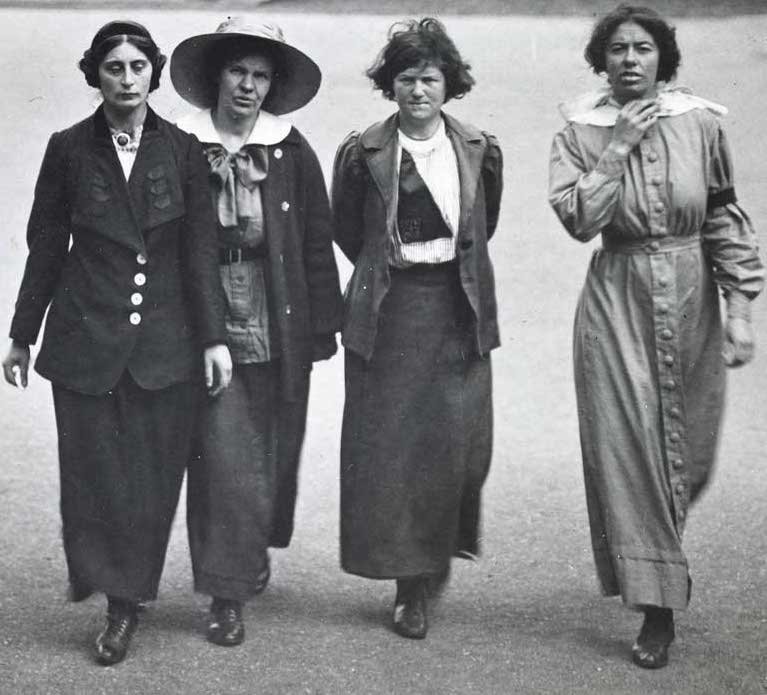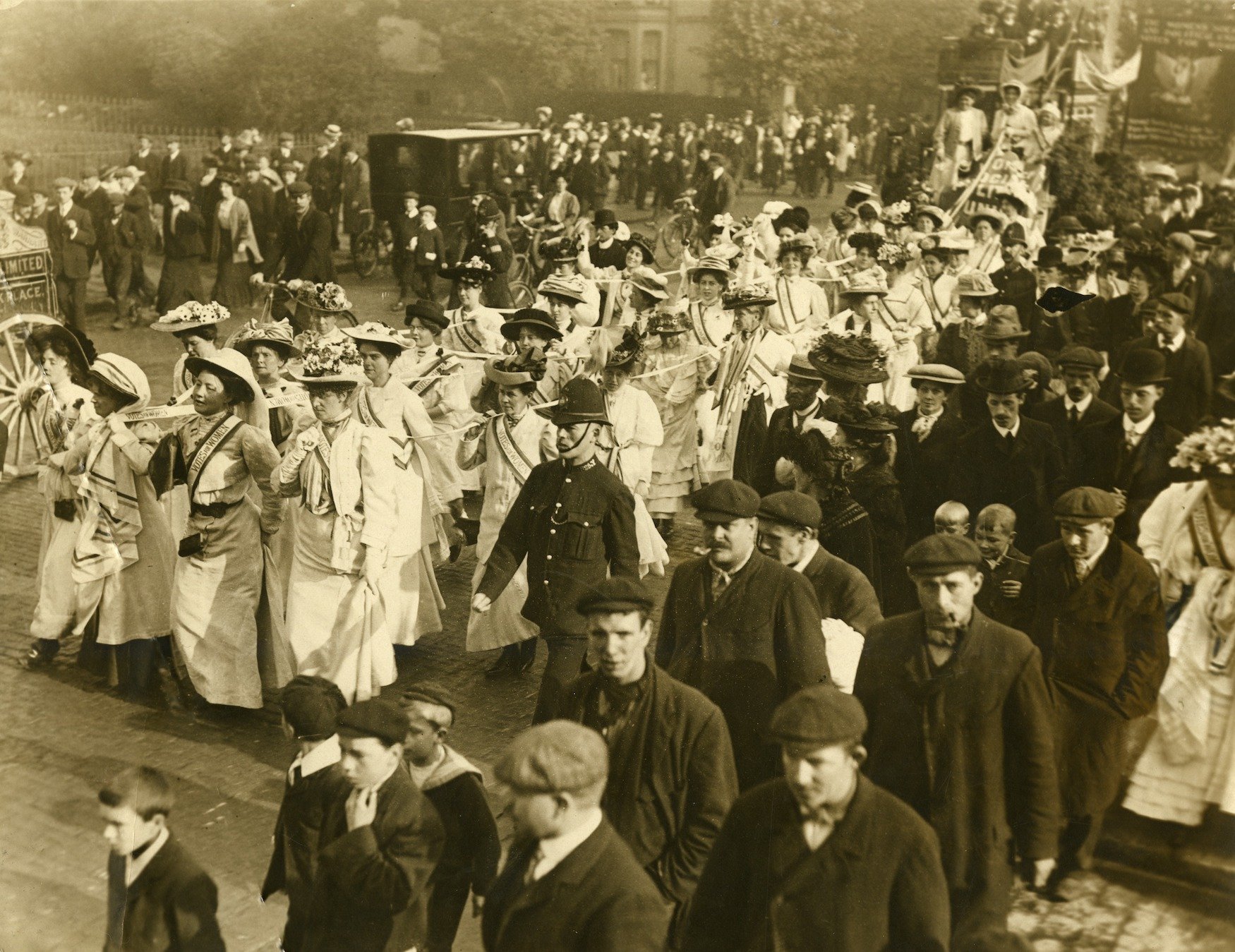
Photos: London Metropolitan Police, public domain via Wikimedia Commons
Suffragettes in Holloway Prison
These remarkable pictures of imprisoned Suffragettes, looking like the Edwardian era’s toughest outlaws, were taken in June 1913 using a hidden surveillance camera at Holloway Prison in North London. The coded label given to the photographs by the authorities illustrates their hostile but wary attitude to the women: it reads ‘wild cats’.
This was the year that the Women’s Social and Political Union (WSPU)’s arson campaign was in full flight. Masterminded by its leader Emmeline Pankhurst’s eldest daughter Christabel, the plan was to cause damage and disrupt lives, putting pressure on the Government to grant women the right to vote. Railway stations, cricket pavilions, empty mansions and racecourse stands all became vulnerable to nighttime attacks. Since the most militant Suffragettes often used false names and identities, the authorities hoped the photographs would enable them to list and monitor them.
Rather tha serving as a deterrent, Victorian gothic-style women-only Holloway Prison had been used by the Suffragettes to create publicity and provoke public sympathy. Adela, the youngest, had urged their followers: “Go to prison, and every paper in the country will know about it, and back you up”. By the time these photographs were taken, more than 1,000 had done just that.
Inside Holloway’s turreted walls the women’s fight became one of grim defiance and personal resilience. In protest at the authorities’ insistence on treating them as common criminals rather than political prisoners, most engaged in hunger strikes, a silent, harrowing form of protest. The response was a regime of force-feeding with rubber tubes, an act so brutally performed, so intentionally violent, that it caused permanent damage to some women, shortening their lives considerably.
The reaction in the country was one of shock and revulsion. In response, the Government passed the ‘Cat and Mouse Act’in 1913. This saw emaciated, frail women released from prison only to be rearrested once they were judged sufficiently strong enough to endure prison life once more. The photographs were planned to make it easier to identify women to be recalled. The subterfuge was embarrassingly thin. The Suffragette newspaper reported, in its 30 April issue that the sound of clicks and the clumsy directions from prison warders that the women were to walk to certain parts of the yard, left them in no doubt that they were being recorded.
The top photograph illustrates that Suffragette prisoners, although a mainly middle-class movement, came from somewhat diverse backgrounds. Margaret Scott, on the far left, was a German-born woman who was concealing her real surname - Schenke - in order to avoid deportation. She was a familiar figure at Hyde Park Corner where she hawked the WSPU’s newspaper and engaged in fiery arguments. Margaret’s candour had been her downfall as she’d revealed a plan to break windows at the Home Office to two ‘sisters’ on a march. They were later revealed to be government spies, employing one of the new methods devised to deal with the Suffragettes’ unprecedented ‘campaign of terror’.
Next to her, Jane Short (aka Rachel Peace) was a working-class embroiderer from a Lewisham family who was
“We are not here because we are lawbreakers; we are here in our efforts to become law makers”
Emmeline Pankhurst
imprisoned for arson, after a mansion in Hampton-on-Thames was destroyed. She was force-fed while hunger-striking on remand, which caused shock in political circles. How could it be right to to treat her this way, asked MPs in the House of Commons, when she had been convicted of no crime? Jane’s trial descended into violence as Suffragettes coloured the court window crimson with pelted tomatoes, and were themselves arrested and imprisoned. She was convicted and sentenced to 18 months hard labour, during which time she was judged too dangerous to let out via the Cat and Mouse Act.
To her right is Margaret McFarlane, a Scottish nurse who had helped Glasgow housemaids to form a branch of London’s Domestic Worker’s Union. Having moved to London to become more active with the WSPU, she had now convicted of breaking two windows of Técla Gem, an international jeweller’s in Bond Street, and the Union held meeting to protest her incarceration. It was her second stretch in Holloway within 18 months.
Completing the formidable line-up is Olive Hockin, described by The Suffragette newspaper as “the Suffragist of artistic - and also arsenal - fame”. This talented creative from an influential landowning family in Cornwall had studied art at the Slade and travelled to Argentina. She had been ambitious in her crimes too: she was convicted of bombing a house southwest of London that was being built for the Prime Minister David Lloyd George, as well as setting fire to Roehampton Golf Course. A police raid on her home uncovered "a perfect arsenal of implements of destruction, including bottles of corrosive fluid, clippers for cutting telegraph wires, fire lighters, hammers, flints, tools of all descriptions in addition to a number of false motor-car identification plates, etc..." Unusually, Olive didn’t hunger strike in Holloway, cutting a deal with the prison guards that she’d eat and drink if they supplied her with art materials.
The second photograph is of Grace Marcon (alias Frieda Graham), a rector’s daughter from a Norfolk village. From her early 20s she operated a stall advocating for votes for women among the displays of cabbages and apples on Norwich market. Her more militant behaviour took place in London, where she had been involved in the window breaking campaign. Grace was now serving a two month sentence after throwing an undisclosed type of powdered irritant over two policeman at a talk given by the Prime Minister David Lloyd George.
Shown alone in the final photograph, wearing a look of heavy suffering, is Olive Beamish, aged around 22. Olive went by the name of Phyllis Brady in Holloway, in part to protect her prominent Irish Protestant family whose details appear in accounts of Ireland’s most prominent families. A WSPU member from the age of 16, when she wore their badge to school, Olive showed her determined character by completing an economics and maths course at Cambridge University despite there being no chance - because she was a woman - of receiving a degree at the end of it. As a Suffragette, she was as daring as she was committed, and together with her accomplice Elsie Duval she had been handpicked for Christabel Pankhurst’s arson campaign. The police had been unable to pin the pair down for an arson on a deserted mansion in Egham, Surrey, although they were spotted cycling fast through nearby countryside at 1am, their faces covered by veils. But the women’s luck ran out when they were spotted struggling with two suspiciously heavy suitcases, and a search revealed them to be packed with paraffin and inflammables. Olive was sentenced to six weeks for attempted arson. In an account of her time in Holloway in the 9 May 1913 edition of The Suffragette newspaper, Olive describes smashing her cell windows, then after commencing a hunger strike, forcibly resisting force-feeding twice daily, claiming that it took two doctors and seven or eight prison officers to overcome her. She quickly became seriously ill, and she and Elsie were the first women to be released under the Cat and Mouse Act.
The inhumane treatment dished out to imprisoned Suffragettes - especially to working-class women - did not break them. If anything, it strengthened their determination, and Holloway became a symbol of defiance. Medals with purple, white and green ribbons were issued to hunger strikers. And the ‘Holloway Brooch’, designed by Sylvia Pankhurst, was awarded on release, after which the ‘ex con’ was pulled through the streets of North London on a cart smothered in floral tributes (shown below in a photograph held by the LSE Library).
In a truly revolutionary move, the Suffragettes rented a house at 12 Dalmeny Avenue, which overlooked the prison, and would shout and sing to encourage ‘their’ inmates, inviting their families to check on them, before finally bombing the prison walls from the garden.

